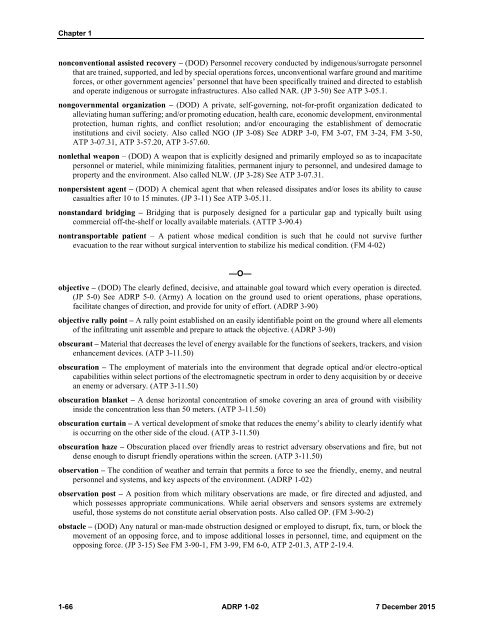ADRP1-02
52543f77c16bcfa46f6e1de2B038ef195
52543f77c16bcfa46f6e1de2B038ef195
You also want an ePaper? Increase the reach of your titles
YUMPU automatically turns print PDFs into web optimized ePapers that Google loves.
Chapter 1<br />
nonconventional assisted recovery – (DOD) Personnel recovery conducted by indigenous/surrogate personnel<br />
that are trained, supported, and led by special operations forces, unconventional warfare ground and maritime<br />
forces, or other government agencies’ personnel that have been specifically trained and directed to establish<br />
and operate indigenous or surrogate infrastructures. Also called NAR. (JP 3-50) See ATP 3-05.1.<br />
nongovernmental organization – (DOD) A private, self-governing, not-for-profit organization dedicated to<br />
alleviating human suffering; and/or promoting education, health care, economic development, environmental<br />
protection, human rights, and conflict resolution; and/or encouraging the establishment of democratic<br />
institutions and civil society. Also called NGO (JP 3-08) See ADRP 3-0, FM 3-07, FM 3-24, FM 3-50,<br />
ATP 3-07.31, ATP 3-57.20, ATP 3-57.60.<br />
nonlethal weapon – (DOD) A weapon that is explicitly designed and primarily employed so as to incapacitate<br />
personnel or materiel, while minimizing fatalities, permanent injury to personnel, and undesired damage to<br />
property and the environment. Also called NLW. (JP 3-28) See ATP 3-07.31.<br />
nonpersistent agent – (DOD) A chemical agent that when released dissipates and/or loses its ability to cause<br />
casualties after 10 to 15 minutes. (JP 3-11) See ATP 3-05.11.<br />
nonstandard bridging – Bridging that is purposely designed for a particular gap and typically built using<br />
commercial off-the-shelf or locally available materials. (ATTP 3-90.4)<br />
nontransportable patient – A patient whose medical condition is such that he could not survive further<br />
evacuation to the rear without surgical intervention to stabilize his medical condition. (FM 4-<strong>02</strong>)<br />
—O—<br />
objective – (DOD) The clearly defined, decisive, and attainable goal toward which every operation is directed.<br />
(JP 5-0) See ADRP 5-0. (Army) A location on the ground used to orient operations, phase operations,<br />
facilitate changes of direction, and provide for unity of effort. (ADRP 3-90)<br />
objective rally point – A rally point established on an easily identifiable point on the ground where all elements<br />
of the infiltrating unit assemble and prepare to attack the objective. (ADRP 3-90)<br />
obscurant – Material that decreases the level of energy available for the functions of seekers, trackers, and vision<br />
enhancement devices. (ATP 3-11.50)<br />
obscuration – The employment of materials into the environment that degrade optical and/or electro-optical<br />
capabilities within select portions of the electromagnetic spectrum in order to deny acquisition by or deceive<br />
an enemy or adversary. (ATP 3-11.50)<br />
obscuration blanket – A dense horizontal concentration of smoke covering an area of ground with visibility<br />
inside the concentration less than 50 meters. (ATP 3-11.50)<br />
obscuration curtain – A vertical development of smoke that reduces the enemy’s ability to clearly identify what<br />
is occurring on the other side of the cloud. (ATP 3-11.50)<br />
obscuration haze – Obscuration placed over friendly areas to restrict adversary observations and fire, but not<br />
dense enough to disrupt friendly operations within the screen. (ATP 3-11.50)<br />
observation – The condition of weather and terrain that permits a force to see the friendly, enemy, and neutral<br />
personnel and systems, and key aspects of the environment. (ADRP 1-<strong>02</strong>)<br />
observation post – A position from which military observations are made, or fire directed and adjusted, and<br />
which possesses appropriate communications. While aerial observers and sensors systems are extremely<br />
useful, those systems do not constitute aerial observation posts. Also called OP. (FM 3-90-2)<br />
obstacle – (DOD) Any natural or man-made obstruction designed or employed to disrupt, fix, turn, or block the<br />
movement of an opposing force, and to impose additional losses in personnel, time, and equipment on the<br />
opposing force. (JP 3-15) See FM 3-90-1, FM 3-99, FM 6-0, ATP 2-01.3, ATP 2-19.4.<br />
1-66 ADRP 1-<strong>02</strong> 7 December 2015


